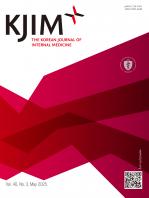|
Gastroenterology / Original Article
Model for end-stage liver disease-3.0 vs. model for end-stage liver disease-sodium: mortality prediction in Korea
Jeong Han Kim, Yong Joon Cho, Won Hyeok Choe, So Young Kwon, Byung-Chul Yoo
Korean J Intern Med. 2024;39(2):248-260. Published online February 1, 2024
Background/Aims: The model for end-stage liver disease (MELD) serves as an indicator for short-term mortality among patients diagnosed with liver cirrhosis (LC) and is used to prioritize patients for liver transplantation. In 2021, the updated version of MELD, MELD-3.0, was introduced to improve the..
|
|
|
Gastroenterology / Original Article
Comparison of the efficacy and safety of direct-acting antiviral therapy with or without hepatitis C-related hepatocellular carcinoma
Byung Soo Kwan, Jeong Han Kim, Seong Jun Park, Won Hyeok Choe, So Young Kwon, Byung-Chul Yoo
Korean J Intern Med. 2021;36(2):292-304. Published online April 3, 2020
Background/Aims: Chronic hepatitis C (CHC) treatment has dramatically improved since direct-acting antiviral (DAA) therapy was introduced. However, the use of DAA therapy in CHC patients with hepatocellular carcinoma (HCC) remains controversial. We investigated the DAA treatment response in CHC pati..
|
|
|
Cardiology / Original Article
Masked inherited primary arrhythmia syndromes in sudden cardiac death patients accompanied by coronary vasospasm
Ki Hong Lee, Hyung Wook Park, Jeong Nam Eun, Jeong Gwan Cho, Nam Sik Yoon, Mi Ran Kim, Yo Han Ku, Hyukjin Park, Seung Hun Lee, Jeong Han Kim, Min Chul Kim, Woo Jin Kim, Hyun Kuk Kim, Jae Yeong Cho, Keun-Ho Park, Doo Sun Sim, Hyun Ju Yoon, Kye Hun Kim, Young Joon Hong, Ju Han Kim, Youngkeun Ahn, Myung Ho Jeong, Jong Chun Park
Korean J Intern Med. 2017;32(5):836-846. Published online August 11, 2017
Background/Aims: Coronary vasospasms are one of the important causes of sudden cardiac death (SCD). Provocation of coronary vasospasms can be useful, though some results may lead to false positives, with patients potentially experiencing recurrent SCD despite appropriate medical treatments. We hypot..
|
|
|
Gastroenterology / Original Article
Incidence of and risk factors for thyroid dysfunction during peginterferon α and ribavirin treatment in patients with chronic hepatitis C
Yong Hwang, Won Kim, So Young Kwon, Hyung Min Yu, Jeong Han Kim, Won Hyeok Choe
Korean J Intern Med. 2015;30(6):792-800. Published online October 30, 2015
Background/Aims: Thyroid dysfunction (TD) is more likely to occur in patients with chronic hepatitis C (CHC) and is particularly associated with interferon (IFN) treatment. The purpose of this study was to investigate the incidence, outcomes, and risk factors for TD during pegylated interferon (PEG-..
|
|
|
Original Article
Significance of Anti-HCV Signal-to-Cutoff Ratio in Predicting Hepatitis C Viremia
Yeon Seok Seo, Eun Suk Jung, Jeong Han Kim, Young Kul Jung, Ji Hoon Kim, Hyonggin An, Hyung Joon Yim, Jong Eun Yeon, Kwan Soo Byun, Chang Duck Kim, Ho Sang Ryu, Soon Ho Um
Korean J Intern Med. 2009;24(4):302-308. Published online November 27, 2009
Background/AimsHepatitis C virus (HCV) RNA testing can be performed using qualitative or quantitative assays, and it is still unclear which is more useful as a primary test in patients positive for anti-HCV. The present study evaluated the usefulness of anti-HCV signal-to-cuto..
|
|
|
















